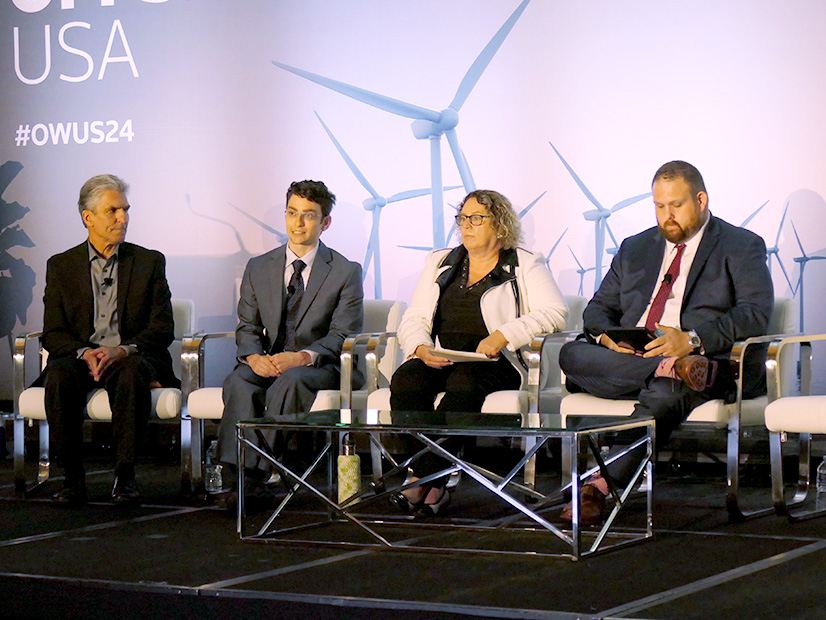
BOSTON — Offshore wind executives and government officials expressed tentative optimism at an offshore wind conference about the industry’s rebound from last year’s spate of contract cancellations.
With construction underway on Vineyard Wind, Revolution Wind and Coastal Virginia Offshore Wind and several earlier-stage projects back under contract or rebid in ongoing state solicitations, the industry is building a foundation heading into the uncertainty of the 2024 election, several speakers emphasized at the June 17-18 Reuters event.
Walter Musial, chief engineer of offshore wind energy at the National Renewable Energy Laboratory, said recent project cancellations have delayed offshore wind’s growth in the U.S. but do not seem likely to have a major impact on its long-term outlook.
Most indicators “generally support the long-term viability of the industry,” Musial said.
Heading into the election, “something that we have not done well enough as an industry is selling the job creation story,” said Teddy Muhlfelder, head of Empire Wind for Equinor.
“It’s a truly exciting story for the U.S., which hasn’t seen new major manufacturing in a long time,” Muhlfelder added. “This impacts red states and blue states.”
Despite the recent rebound, the nascent industry remains reliant on federal and state governments as it scales up. A recent report by the Global Wind Energy Council projected 410 GW of additional global offshore wind capacity to be installed over the next decade, contingent on continued policy support. (See Decade of Strong Growth Forecast in Offshore Wind Sector.)
While the Biden administration has approved eight commercial-scale offshore wind projects, former President Donald Trump did not issue a single offshore wind permit during his presidency and has expressed his disdain for offshore wind on the campaign trail.
Speaking about the Atlantic Shores project at a rally in May, Trump said “we’re going to make sure that that ends on day one — I’m going to write it out in an executive order.”
“We must not take a day for granted,” said Daniel Runyan, head of offshore wind development at Invenergy.
Runyan stressed the need to continue building up the domestic supply chain, noting that “we have the opportunity to see some major investment throughout the United States” that would provide job and economic development benefits “beyond just the megawatt hours.”
Despite the uncertainty at the federal level, speakers applauded the Northeast states’ continued commitment to offshore wind amid the recent rocky waters.
David Ortiz, head of government affairs and market strategy at Ørsted, praised the ongoing coordinated procurement of Connecticut, Massachusetts and Rhode Island. The combined solicitation of up to 6,000 MW received 5,454 MW in bids in March, with winning bids set to be announced Aug. 7. (See New England States’ OSW Procurement Receives 5,454 MW in Bids.)
“We think that this coordinated procurement is a really strong step in the right direction and is really leading this industry,” Ortiz said. “Other states should look this way and follow.”
The coordinated procurement is intended to unlock economies of scale and enable the more efficient use of regional supply chains and ports to reduce overall costs to ratepayers.
Ortiz said the Northeast states could further improve their procurement processes by more closely aligning the commercial operations date requirements and inflation index mechanisms of the three state requests for proposals.
Speakers at the conference also called for permitting improvements to help reduce costs and timelines.
“Permitting needs to be accelerated for offshore wind and every other infrastructure project in the U.S,” said Sy Oytan, COO of offshore wind for Avangrid Renewables. He noted that allocating more resources and funding to relevant government agencies could be one way to speed up timelines.
Beyond just permitting speed, “clarity of time frame is absolutely critical,” said Diane Leopold, COO of Dominion Energy. Leopold said uncertainty regarding the length of the permitting process can directly increase costs, particularly for booking contractors.
Muhlfelder of Equinor also stressed the importance of timeline certainty, calling offshore wind a “schedule-driven” industry.
“You’re forecasting eight years out when a vessel’s going to arrive in a four-month window,” Muhlfelder said. “Having a really good understanding of your schedule is going to be key.”


